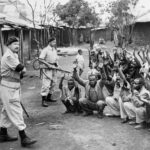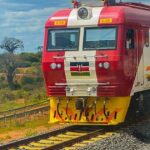En kronologi over vigtige begivenheder i det område, vi i dag kender som Kenya:
Cirka 3,3 millioner f.Kr. Der er fundet beviser på nogle af de tidligste menneskelige redskaber i Kenya, hvilket tyder på, at det var menneskehedens vugge, hvorfra efterkommere bevægede sig ud for at befolke verden.
600 - Araberne begynder at bosætte sig i kystområderne, og i løbet af århundrederne udviklede de handelsstationer, som lettede kontakten med den arabiske verden, Persien og Indien.
1895 - Dannelsen af det britiske østafrikanske protektorat.
1920 - Det østafrikanske protektorat bliver en kronkoloni i Kenya - administreret af en britisk guvernør.
Mau Mau
1944 - Kenyan African Union (KAU) dannes for at kæmpe for afrikansk uafhængighed. Første afrikanske udnævnelse til det lovgivende råd.
1947 - Jomo Kenyatta bliver leder af KAU.
1952-53 - Den hemmelige Kikuyu-guerillagruppe Mau Mau indleder en voldelig kampagne mod hvide bosættere. Der blev erklæret undtagelsestilstand, Jomo Kenyatta blev fængslet, og KAU blev forbudt.
1956 - Mau Mau-oprøret blev bragt til ophør.
1960 - Undtagelsestilstanden ophører. Storbritannien annoncerer planer om at forberede Kenya på afrikansk flertalsstyre. Kenya African National Union (Kanu) blev dannet af Tom Mboya og Oginga Odinga.
Kenyas første
præsident:
Jomo Kenyatta
Kenyas første præsident: Jomo Kenyatta
Uafhængighed
1961 - Jomo Kenyatta blev løsladt efter to års husarrest og overtog præsidentposten efter Kanu.
1963 - Kenya fik sin uafhængighed med Kenyatta som premierminister.
1964 - Republikken Kenya blev dannet. Jomo Kenyatta blev præsident og Oginga Odinga vicepræsident.
1966 - Odinga forlod Kanu efter en ideologisk splittelse og dannede Kenya People's Union (KPU). 1969 - Mordet på premierminister Tom Mboya udløste etniske uroligheder. KPU blev forbudt, og Odinga blev arresteret. Kanu var dermed det eneste parti, der deltog i valget.
1974 - Jomo Kenyatta blev genvalgt.
Mig-epoker
1978 - Kenyatta døde i embedet og blev efterfulgt af vicepræsident Daniel arap Moi.
1982 juni - Nationalforsamlingen erklærede officielt Kenya for at være en etpartistat.
1987 - Oppositionsgrupper blev undertrykt. Det internationale samfund kritiserede politiske anholdelser og krænkelser af menneskerettighederne.
1991 august - Forum for Restoration of Democracy (Ford) blev dannet af seks oppositionsledere, herunder Oginga Odinga. Partiet blev forbudt, og dets medlemmer blev arresteret. Kreditorer suspenderede al støtte til Kenya på grund af hård international fordømmelse.
1991 december - På en særlig konference i Kanu blev man enige om at genindføre et politisk flerpartisystem.
1992 - Omkring 2.000 mennesker blev dræbt i en stammekonflikt i den vestlige del af landet. Der blev afholdt et flerpartivalg
1992 december - Præsident Moi blev genvalgt ved flerpartivalget, og Kanu vandt et stort flertal.
1994 - Oginga Odinga døde. Oppositionsgrupperne dannede en koalition - United National Democratic Alliance - men den var plaget af uoverensstemmelser.
1997 - december Præsident Moi vandt endnu en periode i et meget kritiseret valg. Hans hovedmodstandere var tidligere vicepræsident Mwai Kibaki og Raila Odinga, søn af Oginga Odinga.
Bomben på ambassaden
1998 august - Al-Qaeda-agenter bombede den amerikanske ambassade i Nairobi. I angrebet blev 224 mennesker dræbt og tusindvis såret.
2002 juli - Omkring 200 Maasai- og Samburu-stammefolk accepterede mere end $7 millioner i kompensation fra det britiske forsvarsministerium. Stammefolkene var blevet efterladt eller lemlæstet af sprængstoffer fra den britiske hær, som var blevet efterladt på deres jord i løbet af de sidste 50 år.
2002 november - Al-Qaeda-angreb på israelsk ejet hotel nær Mombasa 10 kenyanere blev dræbt, tre israelere blev såret. Samtidig blev der gennemført et mislykket raketangreb på et israelsk passagerfly.
Kibakis sejr
December 2002 - Der er valg. Mwai Kibaki vinder en jordskredssejr og gør en ende på Daniel arap Mois 24-årige styre og Kanus fire årtier ved magten.
Oktober 2004 - Den kenyanske økolog Wangari Maathai fik Nobels fredspris.
2005 november-december - Vælgerne afviste et forslag til en ny forfatning i det, der blev set som en protest mod præsident Kibaki.
December 2007 - Et omstridt præsidentvalg førte til vold, hvor mere end 1.500 mennesker døde. Regeringen og oppositionen nåede frem til en aftale om magtdeling i februar, og et udvalg nåede frem til en aftale i april. En ny forfatning blev vedtaget.
2010 juli - Kenya gik sammen med sine naboer om at danne et nyt østafrikansk fællesmarked, som skulle integrere regionens økonomi.
2010 august - En ny forfatning blev udarbejdet for at begrænse præsidentens magt og overføre magt til regionerne. Den nye forfatning blev godkendt ved en folkeafstemning.
2011 august-september Somaliske al-Shabab-jihadister udførte operationer mod kenyanske kystbyer og en flygtningelejr. De udførte også aktioner rettet mod udlændinge.
Tropper i Somalia
2011 oktober - Kenyanske tropper gik ind i Somalia for at angribe oprørere, der blev beskyldt for at stå bag flere kidnapninger af udlændinge på kenyansk jord. Kenya blev udsat for flere repressalier.
Januar 2012 - Den Internationale Straffedomstol afgjorde, at flere fremtrædende kenyanere skulle stilles for retten for volden efter valget i 2007.
2012 marts - Der blev fundet olie. Præsident Kibaki hyldede det som et "stort gennembrud".
Maj 2012 - Mere end 30 mennesker blev såret i et angreb på et indkøbscenter i Nairobi udført af al-Shabab.
2012 august-september - Mere end 100 mennesker blev dræbt i sammenstød om jord og ressourcer i forbindelse med kystområder. Fem mennesker døde i optøjer organiseret af muslimske demonstranter i Mombasa efter nedskydningen af prædikanten Aboud Rogo Mohammed, som af FN blev anklaget for at rekruttere og finansiere islamistiske al-Shabab-krigere i Somalia.
Uhuru Kenyattas valgsejr
2013 marts - Uhuru Kenyatta, søn af Kenyas første præsident, vandt præsidentvalget med lidt over 50 % af stemmerne. En indsigelse mod resultatet fra hans hovedrival, premierminister Raila Odinga, blev afvist af højesteret.
Juni 2013 - Den britiske regering beklagede oprigtigt torturen af tusindvis af kenyanere under undertrykkelsen af Mau Mau-oprøret i 1950'erne og lovede 20 millioner pund i kompensation.
September 2013 Vicepræsident William Ruto erklærede sig ikke-skyldig ved Den Internationale Straffedomstol i anklager om forbrydelser mod menneskeheden efter volden efter valget i 2007. Al-Shabab optrappede sine angreb mod landet.
September 2013 Militante somaliske al-Shabab-medlemmer angreb indkøbscentret Westgate i Westlands, Nairobi, dræbte mere end 60 mennesker og krævede, at Kenyas militær trak sig ud af Somalia.
2014 juni - 48 mennesker døde, efter at militante al-Shabab-medlemmer angreb hoteller og en politistation i Mpeketoni nær feriebyen Lamu.
December 2014 Anklagerne ved Den Internationale Straffedomstol frafaldt anklagerne mod præsident Kenyatta for volden efter valget i 2007 med henvisning til utilstrækkelige beviser.
2015 april - Al-Shabab udførte en massakre på Garissa University College i det nordvestlige Kenya og dræbte 148 mennesker.
Februar 2017 - Regeringen erklærede, at en tørke, der ramte en stor del af landet, var en national katastrofe.
Maj 2017 En ny jernbanelinje til flere milliarder dollars, der forbinder Mombasa med hovedstaden Nairobi, blev åbnet. Det var landets største infrastrukturprojekt siden uafhængigheden.
2017 august-oktober Præsident Kenyatta blev erklæret som vinder af præsidentvalget i august og genvalgt i oktober.
2020 januar - Somaliske jihadister fra Al-Shabab angreb militærbasen Camp Simba nær Lamu og dræbte tre amerikanere.
2022 august - Vicepræsident William Ruto vinder præsidentvalget med et snævert flertal og slår sin hovedrival Raila Odinga.
Kilde: BBC
Relaterede indlæg
-
Mau Mau-oprøret - et blodigt kapitel i Kenyas historie
Mau Mau-oprøret begyndte i 1952 som en reaktion på ulighed og uretfærdighed i...
-
Ashanti-imperiets gyldne arv: Et vestafrikansk kraftcenter, der stadig former historien
Guld har altid haft mere end bare pengeværdi i Vestafrika, det har været...
-
At køre på skinnerne: Kenyas SGR og fremtiden for Østafrika
Morgengry på Nairobi Terminus Klokken 6.00 om morgenen summer den store hal på Nairobi Terminus af...


